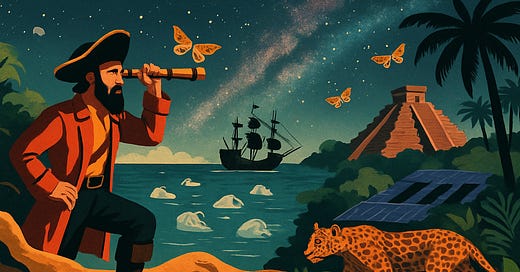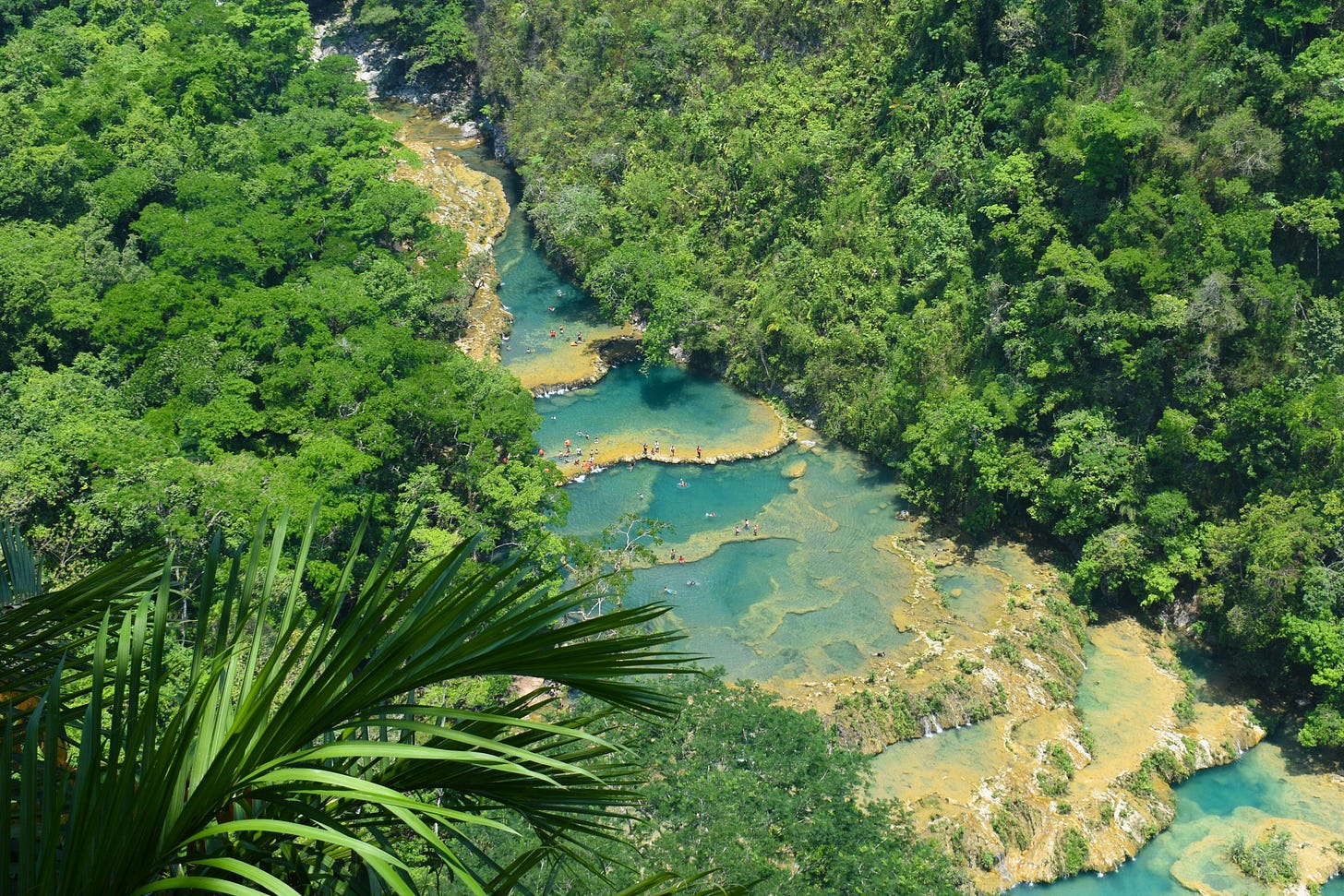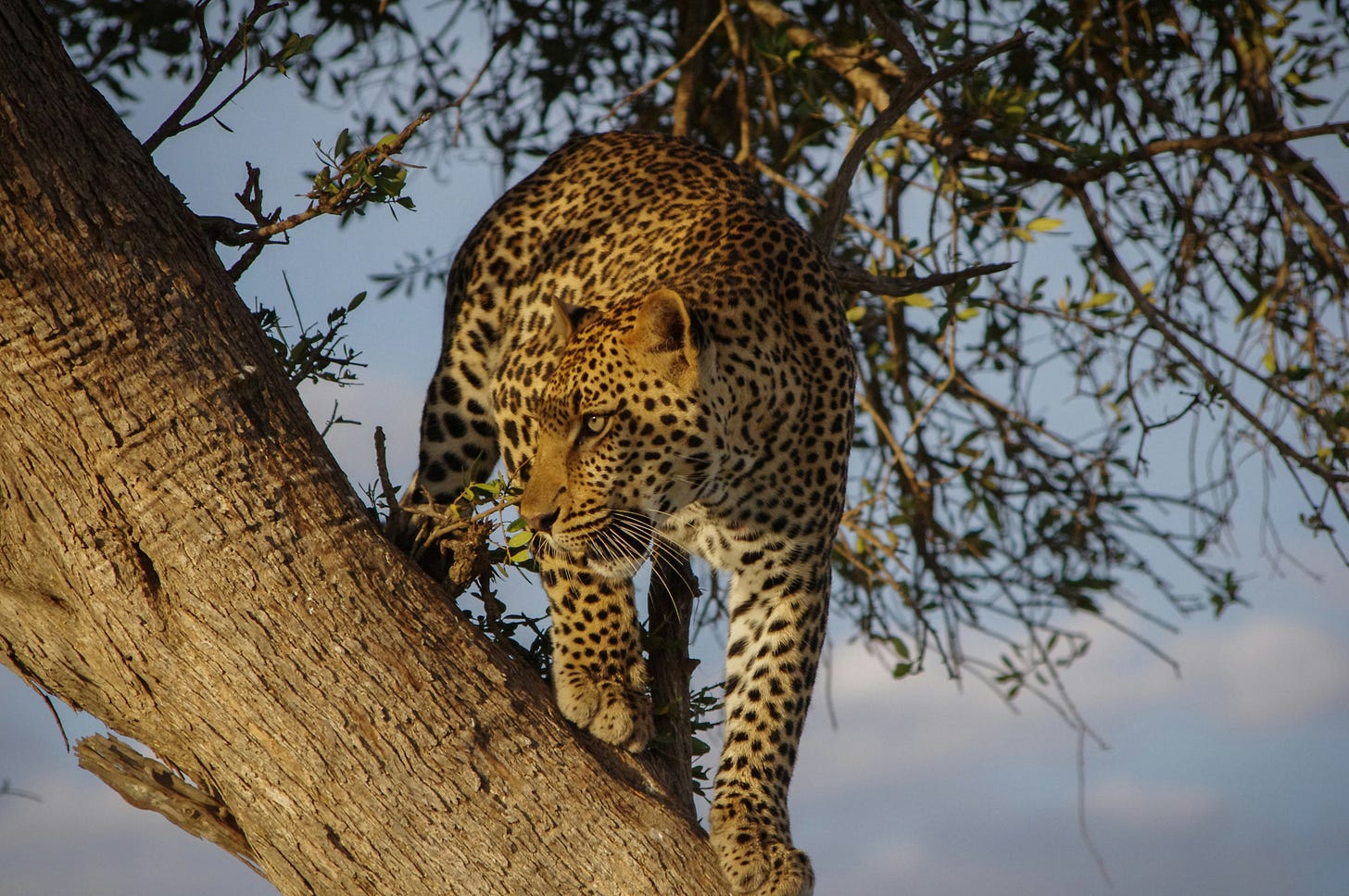Why Your Weekend Walks Make You Smarter (And I'm About to Walk 830 Kilometers)
Plus: Moths navigate by Milky Way, jaguars return from extinction, and pirate treasure hunts in the Caribbean
Today's stories about human adaptability, navigation, and movement are the perfect send-off for my thru-hike in Spain, where I will follow an ancient pilgrimage route to the city of Santiago de Compostela. From early humans mastering impossible environments to moths using the Milky Way as their GPS, the thread connecting everything is simple: we've always been a species that moves, adapts, and finds our way.
Subscribe for independent journalism that delivers breakthrough discoveries, conservation victories, and stories of human ingenuity, and - starting next week - join virtually on the Camino de Santiago via regular updates from one of Europe's most historic pilgrim routes.
Your Brain on Nature
New research from Nottingham Trent University shows that outdoor physical activity significantly enhances cognitive performance in children compared to the same activity done indoors. Even short sessions—just half an hour—led to sharper attention, faster memory recall, and stronger mental control when conducted outside.
Researchers recruited 45 children aged 11 to 13 and had them participate in both indoor and outdoor sessions of a 30-minute basketball activity. The results were striking: outdoor sessions led to faster response times in memory tasks (up to 100 milliseconds faster), more accurate answers in attention-heavy challenges, and lasting improvements that persisted nearly an hour after exercise.
By contrast, indoor activity offered far fewer benefits—and curiously, in some cases, response times actually worsened. The children reported similar levels of enjoyment and didn't show major mood differences between sessions, suggesting that the outdoor advantage comes from something beyond simple physical exertion.
This adds to growing evidence that your body prefers the outdoors. A meta-analysis comparing outdoor versus indoor physical activity found large to moderate effects favoring outdoor activity in terms of anxiety, fatigue, and vitality. Outdoor "green exercise" also correlates with better mood and lower stress.
As I prepare to spend five weeks walking outdoors, this research feels personally relevant. The findings come at a crucial moment, as youth physical activity continues to decline, mental fatigue rises, and access to nature is shrinking in rapidly urbanizing societies. Worldwide, over 80% of adolescents fail to meet movement guidelines.
Masters of the Impossible
Humans are the only animal that lives in virtually every possible environment, from rainforests to deserts to tundra. According to a new study published in Nature, ancient Homo sapiens developed the flexibility to survive by finding food and other resources in a wide variety of difficult habitats before they dispersed from Africa about 50,000 years ago.
Our species first evolved in Africa around 300,000 years ago. While prior fossil finds indicate that some groups made early forays outside the continent, lasting human settlements in other parts of the world didn't occur until a series of migrations around 50,000 years ago.
The scientists assembled a database of archaeological sites showing human presence across Africa from 120,000 to 14,000 years ago. For each site, researchers modeled what the local climate would have been like during the time periods that ancient humans lived there.
"There was a really sharp change in the range of habitats that humans were using starting around 70,000 years ago," said study co-author Emily Hallett, an archaeologist at Loyola University Chicago. "We saw a really clear signal that humans were living in more challenging and more extreme environments."
While humans had long survived in savannas and forests, they shifted into environments ranging from dense rainforests to arid deserts in the period leading up to 50,000 years ago, developing what Hallett called an "ecological flexibility that let them succeed."
The research shows our adaptability isn't modern—it's ancient. Long before we invented technology to survive in hostile environments, we learned to thrive in landscapes that would challenge us today.
Even Earlier Than We Thought
New evidence is strengthening the case that humans reached the Americas far earlier than previously believed. A new line of research at White Sands National Park in New Mexico provides further corroboration of fossilized footprints that rewrite the history of humans in the Americas.
Researchers used radiocarbon dating to determine that the organic matter in wetland muds and shallow lake sediments near the fossilized footprints is between 20,700 and 22,400 years old. That closely correlates to previous findings that the tracks are between 21,000 and 23,000 years old.
The footprints indicate that humans trod the North American landscape thousands of years earlier than previously thought, during the most inhospitable conditions of the last Ice Age. Previous archaeological evidence had suggested that human occupation of North America started roughly 16,000 years ago.
The hunter-gatherers who left the tracks were traversing the floodplain of a river that flowed into an ancient body of water called Lake Otero. The area could have provided important resources, with mammoths, giant ground sloths, camels, and dire wolves roaming the landscape.
"Three separate carbon sources, pollen, seeds, and organic muds and sediments, have now been dated by different radiocarbon labs, and they all indicate a last glacial maximum age for the footprints," said Jason Windingstad, a University of Arizona doctoral candidate and co-author of the study.
University of Arizona archaeologist Vance Holliday, the study leader, said the new findings align with previous research "spectacularly well." The climate was markedly different than today, with cooler summers and the area receiving significantly more precipitation.
One Man's Forest Revolution
In the highlands of western Guatemala, Armando López Pocol has been fighting a quiet war against deforestation for over 25 years. Since 1999, he and his small team of volunteers have planted thousands of trees, regenerating the landscape through the Chico Mendes Reforestation Project.
The project was named after the Brazilian environmentalist Chico Mendes, who fought to preserve the rainforest until he was murdered by a cattle rancher in 1988. "The struggles he went through in Brazil are similar to the ones we go through in Guatemala," Pocol says.
From the 1960s to the 1990s, there was extensive deforestation in Cantel, as wood was used for building houses and as firewood for families. Pocol started his project because he was worried about climate change and environmental problems in Guatemala, with mining companies destroying the community forests of Indigenous people.
Using land owned by the local municipality, the organization has planted between 5,000 and 20,000 trees every year since 1998. Over the last 10 years, this figure has risen to an annual average of 20,000 to 25,000, and it's anticipated that the figure will exceed 30,000 this year.
The project plants eight different types of trees, though Pocol has found the most success with cypress and pine, which flourish in the cooler climates found at higher altitudes. "We plant pine trees because the earth here is very hot, and we don't have many other types of trees that live through the seasons," he says.
Pocol, who works on his project every day, including weekends, and tops up his income as an Uber driver, admits he is exhausted. "I wake up in the night and wonder what the future is going to be for the project," he says. "But I've never given up, and it always lifts my spirits when volunteers come."
Treasure Hunters Set Sail
For the first time in history, marine archaeologists will be allowed to search for pirate ships off Nassau on the island of New Providence—a notorious pirate hideout 300 years ago. The expedition, co-directed by leading British marine archaeologist Dr Sean Kingsley, will explore waters that have never been searched for pirate ships and treasure.
"The potential is enormous," Kingsley said. "We are expecting to find some really cool stuff because this is the real home of the Pirates of the Caribbean. Pirates didn't keep journals listing their lawlessness. What happened in Nassau stayed in Nassau. If we want to discover the truth, we're going to have to dive for it."
The Bahamas was a major crossroads for trade, and more than 500 ships have been wrecked off New Providence since the 1680s. But there may be dozens more, with pirate ships among them. In 1718, when Woodes Rogers sailed to Nassau to become its governor, he noted 40 seized ships on the shore that had been "either burned or sunk" to destroy evidence and "about 700 pirates."
Top of the most-wanted list is the Fancy, a 46-gun flagship. In 1696, privateer Henry Avery sailed to Nassau in this ship, laden with loot from what was described as the greatest pirate heist on the high seas—looting a Mughal treasure ship worth $108 million off India. Avery scuttled the Fancy in Nassau after using some of the treasure to bribe the governor.
The New Providence Pirates Expedition begins in September and has secured the first-ever agreement with the Antiquities, Monuments and Museums Corporation of the Bahamas. Kingsley has explored more than 350 shipwrecks in the last 30 years and expects to identify pirate wrecks by their distinctive mix of French, English, and Dutch ceramics, coins from Arabian to British, and weapons such as stinkpots.
Nature's Star Navigators
On moonless spring nights in Australia, a billion tiny voyagers take to the sky. They are Bogong moths, soft-winged and brown, no bigger than a thumb. And now, scientists have discovered that these invertebrates are doing something once thought exclusive to birds, seals, and stargazing humans: they are navigating by the stars.
Every spring, billions of Bogong moths emerge from the plains of southeastern Australia and fly up to 1,000 kilometers to the alpine caves of the Snowy Mountains in southern New South Wales. There, in dark caverns chilled by elevation, they aestivate, an insect form of hibernation, clinging to rocks in numbers so dense, their bodies blanket the walls.
Come autumn, the same individuals awaken and make the journey home to breed and die. This extraordinary round-trip migration, executed by moths that have never seen their destination before, , has always proved puzzling.
The discovery emerged from a high-tech version of a celestial thought experiment. In a custom-built, magnetically shielded lab in rural New South Wales, researchers tethered Bogong moths inside a flight simulator that mimicked the experience of flying under a natural night sky.
When exposed to a natural austral sky, moths flew in the direction consistent with their seasonal migration, southward in spring, northward in autumn. When researchers rotated the sky projection by 180 degrees, the moths flipped their orientation. And when the stars were scrambled into a meaningless scatter, the moths became disoriented.
The most surprising revelation came from inside the moth's head. Using fine electrodes, researchers recorded activity in neurons from three brain regions involved in navigation. Neurons responded specifically to the orientation of the starry sky. Many of them fired maximally when the moth faced south, its migratory heading in spring.
The moths remain oriented even under cloudy skies, when stars and moon are hidden. In those cases, they appear to switch to their magnetic compass. The dual system mirrors what has been observed in birds like warblers and thrushes, which also combine geomagnetic and stellar cues.
As someone about to navigate ancient paths for over 800 kilometers, I find this remarkable. These tiny creatures accomplish something far more impressive than what I'll be doing—they navigate by reading the sky itself.
Big Cats Making Big Comebacks
Once on the brink of local extinction, jaguar numbers across the Brazil-Argentina Iguaçu-Iguazú border have more than doubled since 2010 thanks to coordinated conservation efforts. The cross-border collaboration between groups in both countries has been crucial to restoring jaguar populations across the Atlantic Forest Green Corridor.
In 2010, the protected area's jaguar population was on the brink of local extinction. Now, thanks to persistent conservation efforts led by Yara Barros, a biologist and executive coordinator of the Jaguars of Iguaçu Project, the big cats' numbers have more than doubled.
Between 1990 and 1995, the Green Corridor, a 185,000-hectare stretch of protected land that links Argentina's Iguazú National Park and Brazil's Iguaçu, was home to between 400 and 800 jaguars. By 2005, that number had dropped to just 40; in 2009, there were about 11 jaguars left in Brazil's Iguaçu National Park. Today, the number of jaguars within the Brazilian side of the park has reached at least 28, and, across the corridor, the population has more than doubled to at least 105.
Meanwhile, in Argentina's El Impenetrable National Park, conservationists are taking an even more ambitious approach. Mini, a female jaguar from Iberá National Park, will soon be translocated to El Impenetrable to boost genetic diversity and reproduction, making her the first jaguar to ever be moved between wild populations, and the first wild-to-wild translocation of any animal in Argentina.
The conservation efforts of Yara Barros and her team were recognized in April when she won the 2025 Whitley Award for her work protecting jaguars in Iguaçu National Park. From educational talks in schools to visiting nearly 2,000 properties and responding to 137 predation incidents, they've started to change local perceptions of the big cat.
"A lot of fear comes from not understanding," Barros said. Today, instead of killing jaguars, landowners first reach out to Barros's team to resolve conflicts.
Small Changes, Big Results
Plastic bag fees and bans are effective in limiting debris on U.S. shorelines, a new study reports. The study, published Thursday in the peer-reviewed journal Science, analyzed the relationship between policies on plastic bags and the litter collected in more than 45,000 shoreline cleanups.
In communities with policies in place, the prevalence of plastic bags in the trash was 25 percent to 47 percent lower than in places without regulations. Bans in three states, New Jersey, Philadelphia and Vermont, and two cities, Portland, Oregon and Santa Barbara, California, have reduced the number of single-use plastic bags used each year by around 6 billion.
Over 500 municipalities in 28 states had plastic bag legislation in effect as of 2021. Additionally, 12 states have single-use plastic bag bans: California, Colorado, Connecticut, Delaware, Hawaii, Maine, New Jersey, New York, Oregon, Rhode Island, Vermont and Washington.
The effectiveness varies dramatically by design. In Santa Barbara, California, where single-use plastic bags are banned in supermarkets, drug stores and convenience stores, the legislation has saved 490 bags per person annually while plastic bag bans at restaurants and retail stores in Philadelphia saved just 127 bags per person annually.
Philadelphia's study shows how adoption takes time to accelerate, but the ban has had sustained effects. The city estimates that the ban prevented over 200 million disposable plastic bags from being distributed in its first year. It took three months for plastic bag usage to decrease in the city and remained steady near zero for the remainder of the study.
From Coal Pits to Solar Power
Converting abandoned or soon-to-close coal mines into solar farms could provide enough power to meet the demands of a country the size of Germany, according to a first-of-its-kind analysis. Researchers from Global Energy Monitor have identified 312 surface coal mines that have been shut since 2020, sprawling over 2,089 square kilometres.
A further 3,731 km² of mine land is set to be abandoned by operators before the end of 2030 as reserves are run down. In total, that means an estimated 446 coal mines and 5,820 km² of abandoned land that could be repurposed for solar projects and generate nearly 300 GW of renewable energy.
China is currently leading the pack on coal-to-solar projects. It has 90 such conversions up and running, with a capacity of 14 GW, and 46 more projects in the pipeline. In Europe, the report singles out Greece, which is "exceptionally well-suited" for turning old coal mines into solar plants.
The analysts estimate that 259,700 permanent jobs could be created at coal-to-solar transition sites, and another 317,500 temporary and construction jobs. That's more than the number of workers the coal industry is expected to shed globally by 2035.
"The legacy of coal is written into the land, but that legacy does not have to define the future," says Cheng Cheng Wu, project manager for the Energy Transition Tracker at Global Energy Monitor. "The same ground that powered the industrial era can help power the climate solutions we now urgently need."
Quantum Networks Take Shape
Scientists in Germany have successfully demonstrated a record-scale quantum communication network using existing infrastructure, a breakthrough that could usher in ultra-secure connections for quantum computers. Researchers at Toshiba Europe sent quantum signals over a 254-kilometer commercial fiber-optic network between Frankfurt and Kehl.
Until now, quantum networks were only feasible at smaller scales, about half this distance, or in strictly controlled lab conditions with expensive cooling equipment. The German experiment used existing telecom infrastructure, standard single-mode fibers already used for today's Internet.
The breakthrough addresses a crucial need. While quantum computing offers unprecedented potential for applications like drug discovery, such immense computational power can also break traditional encryption. "The current communication security methods are based on mathematical problems which are presumed to be quite hard for computers to solve," said Robert Woodward, lead of Fiber-Quantum Communications at Toshiba Europe. "But in the quantum era that assumption breaks down."
The team's approach uses single photons of light to achieve ultra-secure communications, implementing a cutting-edge protocol called twin field quantum key distribution. Instead of information flowing in one direction, their design allows both users to send quantum signals to a central node where the signals are combined, doubling communication distances.
"What is most striking about what we did is that we did it with very practical and scalable technology," said Mirko Pittaluga, former Senior Research Scientist at Toshiba Europe. "We really think that this is a significant step forward for practical and large-scale quantum networks."
The European Commission aims to develop an EU-wide quantum network via its European Quantum Communication Infrastructure Initiative, with the goal of having an operational pan-European quantum communication infrastructure in place by 2027.
Following Ancient Footsteps
Today's stories share a fascinating thread: the power of adaptation and movement. From early humans mastering impossible environments 70,000 years ago to moths reading star maps for thousand-kilometer journeys, from jaguars reclaiming lost territories to abandoned coal mines finding new purpose as solar farms.
Each story shows how change, whether evolutionary, technological, or policy-driven, creates unexpected possibilities. The plastic bag research proves that small policy changes can eliminate billions of single-use items. The coal mine conversions show how industrial scars can become clean energy solutions. The jaguar recoveries demonstrate how dedicated conservation work can bring species back from near-extinction.
On Monday, I join this long tradition of human movement, walking paths that countless others have traveled for over a millennium. My walking guide says I need six weeks, but I have only five. I also need time to share my experiences with you, and there are cities that I want to explore.
While walking the Camino del Norte, Santiago gives me the direction, as it has been the goal of millions of pilgrims before me. But I care less about the end goal while I seek the guidance that comes with each step. Santiago serves as my North Star, the way the Milky Way guides those Australian moths across impossible distances. The destination matters less than what the journey reveals along the way.
I will (likely) take a short break from writing this weekend. I just counted how many days it was since the last time that there was a day that I did not publish this newsletter: 31 days. But I need tomorrow to prepare for the long walk and buy the necessary gear in Oslo, and I will travel all day on Sunday. However, if I find a moment to write, I'll share it with you this weekend.
There will be lessons to be learned on the Camino; you can't walk to Santiago de Compostela without such an experience. One of those lessons might be in plain sight after reading today's stories: just as those Bogong moths navigate by starlight or early humans adapt to impossible environments, a long journey often reveals capabilities we didn't know we possessed.
Your support helps me find these stories each morning before dawn and deliver them with your coffee. The world offers plenty of reasons for despair; I choose to serve you hope, progress, and evidence that human ingenuity and compassion still thrive.
Until the first postcard from Spain, ☕️
Alexander
For those who want to join the journey more closely, and give some support, I'll be sharing daily 10 a.m. snapshots on Patreon, whatever I see at that exact moment, rain or shine. These are not my best photos; instead, they give honest glimpses of the walk, whether I'm trudging through an industrial zone in the rain or catching my breath on a beautiful hillside. Think of it as the unfiltered version of the Camino, captured precisely at 10 a.m. each day.
Or perhaps you liked the article and want to support my writing by buying me a coffee?
Notes
Outdoor exercise benefits: ZME Science, 'Outdoor physical activity is better than indoor for your brain'
Human adaptability: AP News, 'Early humans survived in a range of extreme environments before global migration, study says'
New Mexico footprints: Reuters article not accessible
Guatemala regreening: Guardian article not accessible
Caribbean pirates: Guardian article not accessible
Bogong moths navigation: ZME Science, 'These Moths in Australia Use the Milky Way as a GPS to Fly 1,000 Kilometers'
Jaguar recovery: Mongabay, 'Jaguar recovery unites Brazil and Argentina in conservation effort' and multiple sources
Plastic bag bans: Washington Post, 'Plastic bag fees and bans help limit coastal litter, study finds' and multiple sources
Coal to solar: Euronews, 'Report reveals huge solar power potential of abandoned coal mines'
Quantum network: Euronews article not accessible










"Today's stories about human adaptability, navigation, and movement are the perfect send-off for my thru-hike in Spain, where I will follow an ancient pilgrimage route to the city of Santiago de Compostela."
This issue is indeed a perfect send-off to your Camino. Human adaptability to the outdoors and our connection with nature. From ancient footprints to Señor Pocol, the tree planter, and the benefits of outdoor child's play.
We're looking forward to Postcards. Buen Camino ☕🎒
My morning coffee is going to be more informative because of your Camino journey. Walking (imho) is a form of learning and meditating in the realm of human experience. I’m very excited to receive your postcards😆